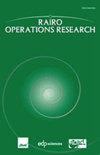基于广告和价格依赖随机需求的信用政策和部分积压下的非瞬时劣化商品库存集成模型。
IF 1.8
4区 管理学
Q3 OPERATIONS RESEARCH & MANAGEMENT SCIENCE
引用次数: 0
摘要
在当今的商业世界中,广告是吸引更多顾客的最重要的政策之一。这一政策增加了零售商的销售额,使零售商的商业地位稳固。本文考虑了具有单一供应商和单一零售商的非瞬时变质物品的集成库存模型,其中供应商通过零售商在市场上销售其产品,零售商面临依赖于零售价格和广告的随机需求。在这里,为了增加零售商的需求,供应商将他/她的产品批发给零售商,并有一个信用期。由于长信贷期增加了需求率,但同时也增加了供应商的机会损失。本文对信用政策进行了探讨,探讨了信用政策对供应商、零售商乃至整个系统的利润影响。购买后,零售商将其产品加价出售给客户。这个加价是根据供应商的批发价和广告费计算的。最后,我们开发了一个综合利润函数,并举例说明了所提出模型的可行性。结果表明,对于维持供应商和零售商的利润以及系统的综合利润来说,合适的广告数量不仅对信用期限更重要,而且更重要。我们分析了加价对利润函数的影响。我们还分析了供应商和零售商的利润结构是如何随着信贷期限的变化而变化的。在求解过程中,提出了一种有效的算法来求解该模型的最优解。并进行了均匀分布的数值算例。最后,对主要参数进行了敏感性分析,以提供管理见解。本文章由计算机程序翻译,如有差异,请以英文原文为准。
An integrated inventory model for non-instantaneous deteriorating item under credit policy and partial backlogging with advertising and price dependent stochastic demand.
In today’s business world, advertising is one of the most important policies to attract more customers. This policy increases the retailer’s sales and makes the retailer’s business position strong. In this paper, we have considered an integrated inventory model for non-instantaneous deteriorating items with a single supplier and single retailer, where a supplier sells his/her products in the market through a retailer who faces a stochastic demand depending on both retail price and advertisement. Here, to increase the retailer’s demand, the supplier wholesales his/her products to the retailer with a credit period. Since the long credit period increases the demand rate but at the same time, it increases the supplier’s opportunity loss. In this paper, we have discussed about the credit policy and find out, how this policy effective on profit of the supplier, the retailer as well as the whole system. After purchasing, the retailer sells his/her products to his customers with a markup. This markup is based on the supplier’s wholesale price and also on advertising costs. Finally, an integrated profit function has been developed and we have illustrated numerical examples to justify the feasibility of the proposed model. The result indicates that not only the credit period but also an appropriate number of advertisements is more important for maintaining the profit of the supplier, the retailer as well as the integrated profit of the system. We have analyzed the effect of markup on the profit function. We have also analyzed how the profit structure of the suppliers and retailers changes along with the changes in the length of the credit period. An effective algorithm has been presented in the solution procedure to find the optimal solutions of the proposed model. Also, the numerical example with uniform distribution has been carried out. Finally, sensitivity analysis of major parameters has been illustrated to provide managerial insights.
求助全文
通过发布文献求助,成功后即可免费获取论文全文。
去求助
来源期刊

Rairo-Operations Research
管理科学-运筹学与管理科学
CiteScore
3.60
自引率
22.20%
发文量
206
审稿时长
>12 weeks
期刊介绍:
RAIRO-Operations Research is an international journal devoted to high-level pure and applied research on all aspects of operations research. All papers published in RAIRO-Operations Research are critically refereed according to international standards. Any paper will either be accepted (possibly with minor revisions) either submitted to another evaluation (after a major revision) or rejected. Every effort will be made by the Editorial Board to ensure a first answer concerning a submitted paper within three months, and a final decision in a period of time not exceeding six months.
 求助内容:
求助内容: 应助结果提醒方式:
应助结果提醒方式:


